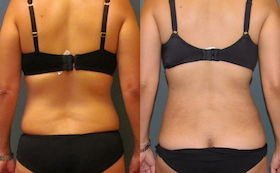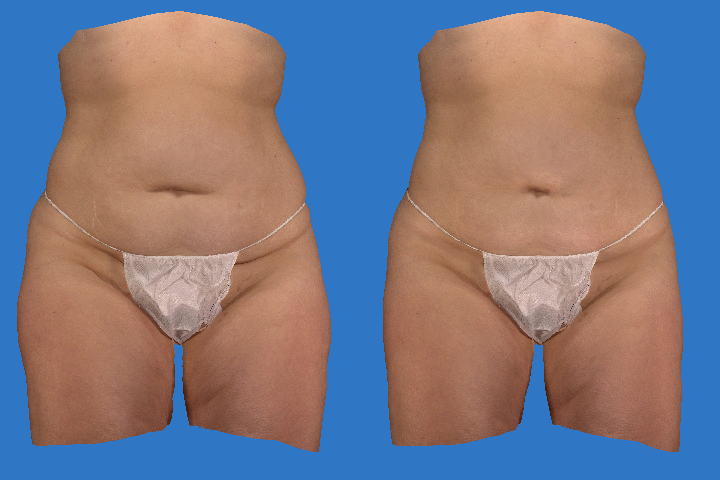Excess fat is a problem that affects many men and women. When an excess of stored fat is confined to a few noticeable areas of the body, it can be frustrating for patients. Even with a healthy diet and exercise routine, it can be difficult to reduce the amount of fatty tissue in certain areas of the body. For patients who are at an appropriate weight for their body type, but still have a surplus of fat in their problem areas, Bay Area Plastic Surgeon John R. Griffin can discuss liposuction.
Vectra 3D Imaging for Liposuction
|
Vectra 3D imaging technology helps patients visualize their potential individual outcomes. During the liposuction consultation, Dr. Griffin will take a 3D image of the patient. Once the image is displayed on his computer screen, Dr. Griffin will simulate a before and after result by modifying the patients contours. The likely outcome can be shown to the patient at any angle. |
Liposuction Candidates
Patients who are good candidates for liposuction will have fatty tissue in specific areas of the body. Liposuction can be performed on targeted areas of the body, including the:
- Thighs
- Hips
- Back
- Flanks
- Arms
- Neck
- Chest
- Abdomen
The most ideal candidates for liposuction will have good skin elasticity. Patients with poor skin elasticity may also wish to undergo a skin tightening surgery, such as a tummy tuck, thigh lift or arm lifts.
Liposuction candidates should be in good health and non-smokers.
Liposuction Techniques
Dr. Griffin performs the superwet and ultrasound-assisted liposuction techniques.
- Superwet (tumescent): This technique involves the injection of a local anesthetic and epinephrine combined in a saline solution prior to surgery. The local anesthetic numbs the treatment area during and after treatment to improve patient comfort. The epinephrine shrinks the blood vessels, reducing pain and bleeding. The saline solution causes the fatty tissue to swell, making it easier to remove. Overall, the tumescent solution reduces bleeding and pain, and results in a better post-operative outcome.
- Ultrasound: This technique involves the use of ultrasound technology to soften the fat and contour the more fibrous areas. The ultrasound waves are emitted from the tip of the cannula, the suctioning device that is used to remove the fat from the body.
Liposuction Procedure Steps
The liposuction procedure involves the following steps:
- The treatment area is marked with a surgical pen
- Antibacterial solution is applied where the incisions will be made
- Anesthesia is administered; patients may undergo general or twilight anesthesia
- The tumescent solution is injected into the treatment area
- A series of tiny incisions are made in a staggered, often asymmetrical fashion so any resulting scarring is less noticeable
- A narrow tube, called a cannula, is inserted into the incisions
- The fat deposits are suctioned out of the body
- The incisions are closed with suture
- Bandages are applied to the treatment area
Liposuction Recovery
Most liposuction procedures are done on an outpatient basis, and patients can return home after the procedure is complete. Patients should rest for the remainder of the day, and continue to take it easy for the first few days after surgery. As soon as patients feel up to it, they should take brief walks around the house to encourage circulation.
Patients will be given a compression garment to wear for two to six weeks following surgery. This will reduce the amount of swelling following surgery, and help the skin conform to the new body contour. During this period, patients should avoid strenuous workouts; instead, they can gradually increase activity and maintain a healthy diet.
Liposuction Side Effects
The most common side effects from liposuction are swelling, bruising, and discomfort. These will begin to fade within a week to 10 days following surgery. Most bruising and discomfort subsides by two to three weeks after surgery, but swelling can take a few months to completely dissipate.
Liposuction Risks
Significant risks from liposuction are relatively rare. However, some potential risks might include infection, scarring, blood pooling under the skin (hematoma), or possible nerve damage. Patients should discuss any concerns with Dr. Griffin at their consultation visit. Comprehensive content forms will detail the risks of this procedure.
 Liposuction Results
Liposuction Results
It will take several months before patients will see the final results of their liposuction procedure. As the swelling goes down, patients will gradually see the final result take shape. Typically, the majority of swelling is gone six weeks after surgery, and patients will have a good idea of what their shape looks like at this time.
Patients should be aware that sudden weight gain or pregnancy may affect body contour. To avoid reversing the results of liposuction, patients should be committed to maintaining a healthy lifestyle. See our liposuction before and after photo gallery.
Liposuction Consultations
To schedule a liposuction consultation, contact Dr. John Griffin’s practice today.








